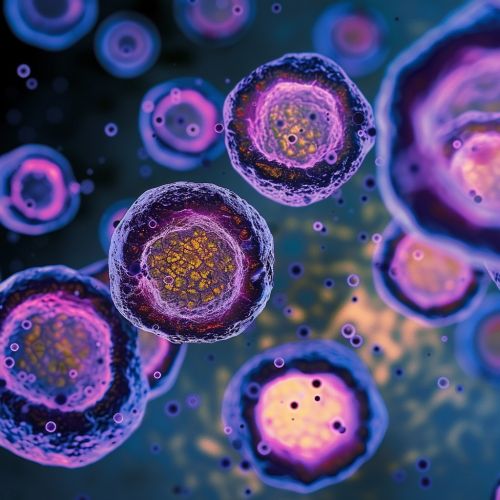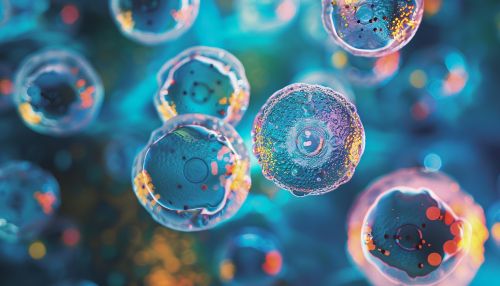E2F transcription factors: Difference between revisions
(Created page with "== Introduction == E2F transcription factors are a family of genes that play a crucial role in regulating the cell cycle and the action of tumor suppressor proteins. They are essential for the control of cell proliferation and are implicated in the regulation of DNA replication, DNA repair, and apoptosis. E2F transcription factors are involved in various cellular processes, including cell growth, differentiation, and development. == Structure and Function == E2F trans...") |
No edit summary |
||
| Line 9: | Line 9: | ||
The E2F proteins can be broadly categorized into two groups based on their function: activators and repressors. Activator E2Fs (E2F1, E2F2, and E2F3a) promote the transcription of genes required for S-phase entry and DNA synthesis. In contrast, repressor E2Fs (E2F3b, E2F4, E2F5, E2F6, E2F7, and E2F8) inhibit the transcription of these genes, thereby preventing uncontrolled cell proliferation. | The E2F proteins can be broadly categorized into two groups based on their function: activators and repressors. Activator E2Fs (E2F1, E2F2, and E2F3a) promote the transcription of genes required for S-phase entry and DNA synthesis. In contrast, repressor E2Fs (E2F3b, E2F4, E2F5, E2F6, E2F7, and E2F8) inhibit the transcription of these genes, thereby preventing uncontrolled cell proliferation. | ||
[[Image:Detail-91319.jpg|thumb|center|Microscopic image of cells in different stages of the cell cycle.|class=only_on_mobile]] | |||
[[Image:Detail-91320.jpg|thumb|center|Microscopic image of cells in different stages of the cell cycle.|class=only_on_desktop]] | |||
== Regulation of E2F Activity == | == Regulation of E2F Activity == | ||
Latest revision as of 20:01, 21 June 2024
Introduction
E2F transcription factors are a family of genes that play a crucial role in regulating the cell cycle and the action of tumor suppressor proteins. They are essential for the control of cell proliferation and are implicated in the regulation of DNA replication, DNA repair, and apoptosis. E2F transcription factors are involved in various cellular processes, including cell growth, differentiation, and development.
Structure and Function
E2F transcription factors are characterized by their ability to bind to specific DNA sequences known as E2F sites, which are found in the promoters of various genes involved in cell cycle regulation. The E2F family consists of several members, each with distinct but overlapping functions. These members include E2F1, E2F2, E2F3, E2F4, E2F5, E2F6, E2F7, and E2F8.
The E2F proteins can be broadly categorized into two groups based on their function: activators and repressors. Activator E2Fs (E2F1, E2F2, and E2F3a) promote the transcription of genes required for S-phase entry and DNA synthesis. In contrast, repressor E2Fs (E2F3b, E2F4, E2F5, E2F6, E2F7, and E2F8) inhibit the transcription of these genes, thereby preventing uncontrolled cell proliferation.


Regulation of E2F Activity
The activity of E2F transcription factors is tightly regulated by their interaction with the retinoblastoma (Rb) protein family, which includes pRb, p107, and p130. In their hypophosphorylated state, Rb proteins bind to E2F transcription factors, preventing them from activating target genes. Upon phosphorylation by cyclin-dependent kinases (CDKs), Rb proteins release E2Fs, allowing them to activate the transcription of genes necessary for cell cycle progression.
Additionally, E2F activity is modulated by various post-translational modifications, including phosphorylation, acetylation, and ubiquitination. These modifications can alter the stability, localization, and DNA-binding affinity of E2F proteins, thereby fine-tuning their regulatory functions.
Role in Cell Cycle Control
E2F transcription factors are pivotal in the regulation of the cell cycle, particularly the transition from the G1 to the S phase. During the G1 phase, repressor E2Fs are bound to Rb proteins, keeping the expression of S-phase genes in check. As cells progress through the G1 phase, CDKs phosphorylate Rb proteins, leading to the release of activator E2Fs. These activator E2Fs then induce the expression of genes required for DNA replication and S-phase entry.
The precise control of E2F activity is essential for maintaining normal cell cycle progression and preventing aberrant cell proliferation, which can lead to tumorigenesis.
E2F and Cancer
Dysregulation of E2F transcription factors is commonly observed in various cancers. Overexpression of activator E2Fs or loss of repressor E2Fs can lead to uncontrolled cell proliferation and tumor development. Mutations in the Rb pathway, which disrupt the regulation of E2F activity, are frequently found in many types of cancer, including retinoblastoma, osteosarcoma, and small cell lung carcinoma.
E2F1, in particular, has been shown to have a dual role in cancer. While it promotes cell proliferation, it can also induce apoptosis in response to DNA damage or oncogenic stress. This pro-apoptotic function of E2F1 is thought to act as a safeguard against tumorigenesis, highlighting the complex role of E2F transcription factors in cancer biology.
E2F in Development and Differentiation
Beyond their role in cell cycle control, E2F transcription factors are also involved in the regulation of development and differentiation. E2F proteins have been shown to influence the differentiation of various cell types, including muscle cells, neurons, and hematopoietic cells. For instance, E2F4 and E2F5 are essential for the proper development of the central nervous system, while E2F1 and E2F2 are required for the differentiation of T cells.
The precise mechanisms by which E2F transcription factors regulate differentiation are still being elucidated. However, it is clear that they play a critical role in coordinating the balance between cell proliferation and differentiation during development.
E2F and Apoptosis
E2F transcription factors are also key regulators of apoptosis. E2F1, in particular, can induce apoptosis in response to various stimuli, including DNA damage, oncogenic stress, and cytokine withdrawal. The pro-apoptotic function of E2F1 is mediated through the transcriptional activation of genes involved in the apoptotic pathway, such as p53, Apaf-1, and caspases.
The ability of E2F1 to induce apoptosis is thought to act as a tumor suppressive mechanism, preventing the survival and proliferation of cells with damaged DNA or oncogenic mutations. However, the dysregulation of E2F1 and other E2F family members can disrupt this balance, contributing to tumorigenesis.
Therapeutic Targeting of E2F
Given the critical role of E2F transcription factors in cell cycle regulation and cancer, they represent attractive targets for therapeutic intervention. Several strategies have been explored to target E2F activity in cancer, including the development of small molecule inhibitors, antisense oligonucleotides, and RNA interference approaches.
One promising approach is the use of CDK inhibitors, which can prevent the phosphorylation of Rb proteins and thereby inhibit the release of E2Fs. This strategy has shown efficacy in preclinical models and is currently being evaluated in clinical trials for various cancers.
Another approach is the direct targeting of E2F transcription factors using small molecules or peptides that disrupt their DNA-binding activity or protein-protein interactions. While these approaches are still in the early stages of development, they hold potential for the selective inhibition of E2F activity in cancer cells.
Conclusion
E2F transcription factors are essential regulators of cell cycle progression, apoptosis, and differentiation. Their dysregulation is a common feature of many cancers, making them important targets for therapeutic intervention. Ongoing research continues to uncover the complex roles of E2F transcription factors in normal cellular processes and disease, providing new insights into their potential as targets for cancer therapy.
